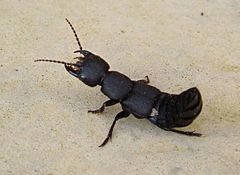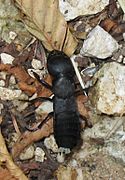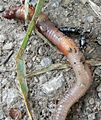Devil's coach horse beetle facts for kids
Quick facts for kids Devil's coach-horse beetle |
|
|---|---|
 |
|
| Scientific classification | |
| Kingdom: | |
| Phylum: | |
| Class: | |
| Order: | |
| Family: | |
| Genus: |
Ocypus
|
| Species: |
O. olens
|
| Binomial name | |
| Ocypus olens (O. F. Müller, 1764)
|
|
| Synonyms | |
|
Staphylinus olens O. F. Müller, 1764 |
|
The Devil's coach-horse beetle is a common insect found across Europe. It is also known as the Cocktail beetle. This interesting creature belongs to a group of insects called rove beetles.
Contents
Where It Lives and What It Likes
These beetles are very common and can be found in most parts of Europe. They also live in North Africa. People have even brought them to the Americas and parts of Australasia.
Devil's coach-horse beetles like places that are a bit damp. You can find them from April to October. They live in meadows, forests, gardens, and parks. During the day, they often hide under logs, stones, or piles of leaves.
What It Looks Like
This beetle has a long, black body. It can grow to be about 20 to 32 millimeters long. This makes it one of the bigger beetles in Britain.
Its wing covers, called elytra, are quite short. They only cover its thorax (the middle part of its body). This leaves most of its abdomen (the back part) uncovered. The abdomen has strong muscles and hard plates.
Even though it has wings, this beetle rarely flies. It is covered in fine, black hairs. When it feels threatened, it will raise its long abdomen. It also opens its strong jaws, looking a bit like a scorpion. It doesn't have a sting, but it can give a painful bite. It also lets out a bad-smelling liquid from glands at the end of its abdomen to scare away enemies.
How It Lives and What It Eats
The Devil's coach-horse beetle is a predator. This means it hunts other creatures for food. It mostly hunts at night. It eats many different invertebrates, which are animals without backbones.
Its diet includes worms, slugs, spiders, small moths, and woodlice. It also eats dead animals, which is called carrion. It catches its prey with its strong jaws, called mandibles. It uses its front legs to help move the food.
The beetle chews its food into a ball. It then swallows it, and a brown liquid helps break it down. It keeps chewing and swallowing until the food becomes a liquid. It leaves behind hard parts like skin or shells. Young beetles, called larvae, also eat the same types of food.
How It Reproduces
Devil's coach-horse beetles mate in the autumn. Females lay their eggs about two to three weeks after mating. The eggs are large, about 4 millimeters, and white with a dark band.
They lay each egg separately in damp places. These spots can be under moss, stones, or leaves. After about 30 days, the eggs hatch. The larvae that come out are white with a straw-colored head.
The larvae mostly live underground. They eat the same food as the adult beetles. They also have strong jaws and will raise their tails when they feel threatened. The larva grows through three stages, called instars. The last stage can be 20 to 26 millimeters long.
When the larva is about 150 days old, it changes into a pupa. This stage lasts about 35 days. After this, an adult beetle comes out. Its wings take a few hours to fully form and fold under its wing covers. Adult beetles can live through a second winter. Some hide in burrows and come out in March, while others stay active.
Gallery
Images for kids
See also
 In Spanish: Escarabajo errante para niños
In Spanish: Escarabajo errante para niños








